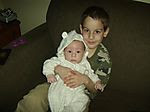From I want to learn about spina bifida
Learning About SB: What is in that? The Latex Question
 Latex. Sometimes it seems like it is the centre of my universe. Everything we buy I turn over and look (most often in vain) for a component list and look for those words. Natural Rubber Latex (NRL). What is the big deal?
Latex. Sometimes it seems like it is the centre of my universe. Everything we buy I turn over and look (most often in vain) for a component list and look for those words. Natural Rubber Latex (NRL). What is the big deal?It was believed that 73% children with spina bifida have a latex allergy. At first it was because they were exposed to latex at such an early age with multiple operations. But since many hospitals go latex free, and Sick Kids in Toronto is one hospital, we’ve kept him from being exposed to latex through the hospital. So something about spina bifida makes them allergic to latex. I’ve tried to find research that says it is not related, that now that kids aren’t being exposed to latex at and after birth the rates of latex allergy went away. But there is no research that says that. So I’m pretty much outta luck there. It is very clear that spina bifida is a risk factor for developing a latex allergy.
If you remember I had my c-section latex-free to keep Nickolas from being exposed through my own surgery.
You’d think that it would be simple to keep away from latex. Not so much. It is everywhere. Really rubber is in so much stuff, to make it better, to make it stretchier or bouncier or more durable. So what do we look out for? There are lists available online. I like this one here. It is 4 pages long, things in the hospital and then things in the community. Pretty daunting when you are worried about everything else about spina bifida. This is just one more thing that is tossed on the pile, and you worry that it will topple everything over!
So what exactly has latex in it? First of all rubber gloves, balloons, condoms. OK we can stay away from those. Medical supplies are pretty clear about what contains latex. I’m not going to get into hospital and medical equipment with latex. But it gets a bit tricky when we look at things in the community. Tape, office supplies, balls, mats, gum, elastics, t-shirt logos, costumes, band aids, diapers, nipples, handle bars, mattresses, newsprint, lottery scratch tickets, soothers, toothbrushes, bungee cords, playgrounds, toys, water toys, bathing suits, goggles, and zipper storage bags. Are you dizzy yet? And that is just the quick list. There are a lot of alternatives as well. If you want to be very specific with latex allergies it can even go as far as being served food that was prepared with latex gloves, or being in a room with balloons or gloves as latex powder can become airborne.
There is also associated allergies with banana, avocado, chestnut, kiwi, pineapple, mango, passionfruit, strawberry, potato and pear.
Latex comes from the sap of rubber trees. The allergy comes from an immune reaction to proteins in the tree sap.
The allergic reaction is labelled as different types, from 1 (most severe) 4/5 (mild). Type 1 is the one associated with myelomeningocele (spina bifida). It can start off as itchy, watery eyes, sneezing, coughing and rash. But can also become life threatening with difficulty breathing and anaphylactic shock with a collapse of circulation system (pretty much your body decides to shut down).
Boy, isn’t this fun?! Natural rubber is the only thing that we are concerned with. Synthetic rubber, silicone, plastic, nitrile and vinyl are fine to use. Latex is required to be labelled on medical products. But for some reason no one sees the need to label community products. Even when a lot of the products I have looked at are latex free! It would be nice to know!!! For baby products Learning Curve, Kids II and Nuby are companies that I have contacted and have told me that their products are latex free, except for latex nipples.
There are still things that I have a bit of a heart-stop and think Oh God does that have latex in it? Usually around items in clothing and toys. This seems to be a fight that I will have to overcome, until the government decides to smarten up and be concerned about labelling products that have latex. (Do I sound bitter yet)
Sources:
http://www.spinabifidaassociation.org/site/c.liKWL7PLLrF/b.2700271/k.1779/Latex_Natural_Rubber_Allergy_in_Spina_Bifida.htm
http://en.wikipedia.org/wiki/Latex_allergy - and yes I know I used Wikipedia (which is usually evil) but it served it’s purpose today.




























